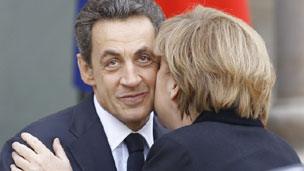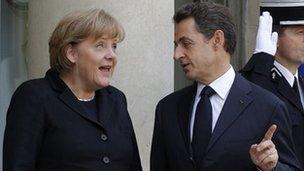Sarkozy and Merkel: What does their body language tell us?
- Published
President Sarkozy greets Chancellor Merkel in Paris
German Chancellor Angela Merkel and French President Nicolas Sarkozy have met in Paris for crunch talks about the future of the eurozone. They spoke about their plans to rescue the single currency, but what did their non-verbal communication tell us?
When Chancellor Merkel arrived at the Elysee Palace, there were still some differences to iron out with Mr Sarkozy, over how to save the euro.
They have met many times but on this occasion, there was much at stake. Could anything be gleaned from their body language?
While some people believe that physical expressions don't tell us very much, others think they play a large part in communication and may provide clues to one's inner thoughts.
Two body language experts give their views on how the two leaders interacted.
The kiss v handshake

"When she emerges from the car, the greeting ritual and then the posed handshake are both full of status and control signals, with Mr Sarkozy just about ensuring he comes out on top in body language terms both times," says behaviour expert Judi James.
"Although Mrs Merkel instigates the handshake as she gets out of the car, her hand is refused by Mr Sarkozy who turns the ritual into a greeting kiss instead.
"This suggests a clash of cultures with neither leader keen to give way to the other, and although Mrs Merkel succumbs to the French form of greeting, she re-boots the handshake once it's over."
The mixed-up greeting suggests Mr Sarkozy initially lost, then regained control, says body language expert Robert Phipps.
"Because he missed her hand first time round, he then reinitiates the handshake, holding onto to her hand as he angles his body and places his left hand behind Mrs Merkel's back to guide her inside. This is Mr Sarkozy taking the control back as the host on his own turf.
"He can be forgiven on this occasion for getting the handshake wrong as in previous encounters the pair have just gone for the kisses on cheeks and done away with the handshake altogether."
The photo-opp
"When they reach the top of the steps, Mr Sarkozy appears unfeasibly buoyant given the 'last chance saloon' mood of their meeting," says Ms James.

"Again he looks keen to stamp his control and leadership over their body language, tapping Mrs Merkel quite firmly on the arm to remind her there's still the photo-opportunity handshake in the offing, and keeping in mind that the one who instigates the shake is normally seen to be the one in charge of the meeting."
Their smiles might look friendly, she says, but there's quite a large distance between them and Mr Sarkozy's grin looks stretched and rigid.
"He emphasises his air of being in charge by tapping Mrs Merkel back into place for further shots. This is a trick Margaret Thatcher used at world summits, where she would often choreograph the line-ups by moving heads of state into position and therefore look in charge of the group."
Unlike the initial greeting, where Mrs Merkel tried to take control by extending her right hand first, notes Mr Phipps, this time on the steps it is Mr Sarkozy who initiates the handshake. He also uses his right hand again to pull Mrs Merkel toward him slightly as they talk.
The power digits

Mr Sarkozy then brings out his famous "power digit", says Ms James.
"He often brings this commanding pointing index finger into play during meetings with other world leaders, usually to stab them in the chest in a playful but dominant way.
"This time, his power digit seemed to be used to refer to the weather, but he must know the shots will show a man appearing to be laying down the law to his German counterpart, demanding her attention as he leads the conversation."
The press conference
There were no visible cues used to suggest good news or even relief, says Ms James.

"Sarkozy maintained some of his signature bounce but his expression was grave and his gestures suggested some underlying anxiety. There was also no real attempt to play at the usual 'special relationship' rituals that we've seen previously.
"While Sarkozy spoke, Merkel either looked down, scribbled notes or even looked slightly away rather than gazing at him and nodding throughout as other leaders have done.
"Her expression remained dour and she ranged from holding onto her lectern while fidgeting on her feet to pressing her nails into the sides in a gesture that suggested tension."
Visually this was not a victory speech, she says, or one that would even have sent out signals of reassurance.